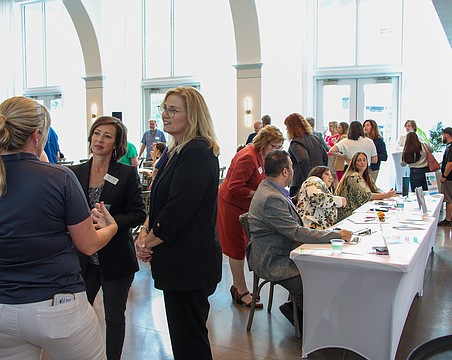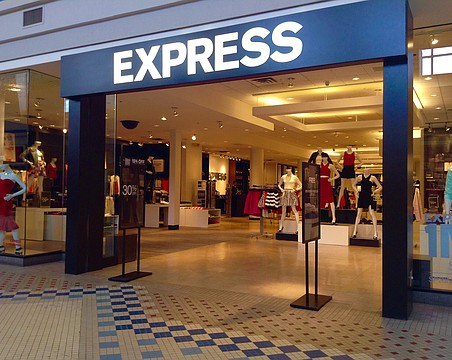Solution: Imagination
Stodgy isn't allowed at Fawley Bryant Architects Inc.
By Sean Roth
Real Estate Editor
Michael Bryant and Richard Fawley say architects are nearly as bad as doctors when it comes to managing a business. It has been a struggle to get Bradenton-based Fawley Bryant Architects Inc. into tip-top financial shape. But with the help of the Boston area architectural consultant company ZweigWhite, the past five years have been good for Fawley Bryant.
The decade old company has grown by 64% in the past three years, from $1.8 million to more than $3 million. In that time, Fawley Bryant has become one of the largest architectural firms in Sarasota and Manatee counties and has landed some of the area's most important projects. The construction value of all projects designed by Fawley Bryant is approaching the half-billion dollar mark.
While the two partners say that the firm has to stay a generalist because of the Gulf Coast market, Fawley Bryant has established a strong niche designing municipal projects, primarily education-related buildings. Those projects include Palmetto Elementary School, Manatee High School, Manatee Community College Center For Innovation & Technology at Lakewood Ranch, Freedom and McNeal elementary schools, Lee Middle School, Lincoln Middle School, the $20 million Lake Erie School of Osteopathic Medicine and the $25 million Manatee Technical Institute.
The majority of the firm's work involves schools because of demand, Fawley says. With the area's explosive population growth and changing demographics, new school construction is commonplace. It doesn't hurt that "these are the projects that everybody recognizes," he says.
There is, however, a downside to building schools. Budgets for new school facilities are tight, which means that school officials expect architects to create more building for less money.
"Our solution is imagination," Fawley says. "We get a lot of comments about Manatee Elementary School, because of the colored pencils on the side of the building. That is just stucco and paint. You can do a lot based on how you use your materials. When we were designing Lee Middle School we decided to build a square. It is the most efficient form there is. A square is 20% more efficient in the area that it encloses. It's a big challenge, and we like that. There is nothing more gratifying then figuring out how to make an impossible list of requirements work."
Those efficiencies have been noticed. Two of Fawley Bryant's Manatee County middle schools - Lee and Lincoln - qualified for the "SMART" designation by the Florida Department of Education. Citing the frugality in design, the state sent rebates of about $3.5 million to the school district.
Fawley Bryant's work helped the firm land the $52 million Manatee County Judicial Center project. When the center's design was being debated, a number of influential people were clamoring for a Mediterranean design. Fawley Bryant proposed a more classical design, and won the contract.
"There is a need to respond to the context of the surrounding buildings," says Bryant. "(Our design) reflected more of a classical Federalist style.
Early in its business life, Fawley Bryant designed the contentious waterfront Bradenton City Center. "That project caused most of the city council and mayor to be voted out of office," says Fawley. "People were ready to storm the Bastille. But lately even the most staunch opponents of the plan have told me how good it looks."
The two partners have applied that ingenuity to their own building on Manatee Avenue. In order to break up the office's cubicle feel, the partners separated the workstations with tall wooden panels, painted in bright primary colors, with a triangle on the top.
"These are their homes away from home," Fawley says. " There is no such thing as a 40-hour work week in architecture. So we gave them roofs. That is the beauty of the design process."
The firm has also found a secondary niche in the recreation market primarily designing country clubs. The firm designed the El Conquistador Country Club, Bradenton Country Club and the Isla del Sol Yacht & Country Club, St. Petersburg. In addition, the firm has designed office buildings and restaurants, including University Professional Center, Johnny Leverock's Seafood House, American Bank's corporate headquarters and the Salvation Army's local social services center.
The company designs private residential projects for clients, but it shies away from the condominium market because of its litigious nature. It also avoids shopping center work.
"We are not into providing down and dirty architectural services," says Fawley. "If someone just wants a set of plans, we typically choose not to work with them."
In 1994, the two partners merged their individual practices. They'd previously met at an association meeting for architects.
Bryant, who had grown up in Bradenton, had opened his private practice after getting a master's degree in architecture from Virginia Tech. Fawley, who had moved to Bradenton from Vermont in 1983, had set up his firm with a focus on school, office and multifamily projects.
"We met (again) at the Lost Kangaroo (a pub on Bradenton's Main Street)," says Fawley. "We saw that a lot of the older gentlemen were being bought out by large national companies. It seemed that everybody was looking for a buyout. The larger firms saw the growth that was coming."
The pressure of competing against the national companies and the desire to do larger projects forced the two firms together. Shortly after the merger, the firm was chosen for what at the time was the largest construction project planned in Bradenton - the $21 million renovation of Manatee High School.
"We only competed on the school work," Bryant says. "We figured that two heads were better than one. Each of us only had two or three employees."
A year later, Bryant and his staff moved into Fawley's office at the high-profile 1001 Manatee Avenue W. location in Bradenton. It has remained the firm's headquarters.
'Kicking and screaming'
Shortly after the merger, the partners decided to expand their coverage to include projects in Jacksonville, Fort Lauderdale and Palm Beach.
"That was one of the mistakes that we made," says Bryant. "There was just too much competition."
Fawley agrees, adding, "It just a totally different political climate."
From that mistake, the partners decided to limit the firm's coverage area to Southwest Florida - Pinellas County south to Lee and Glades counties. The firm makes a few rare exceptions. It's doing deals in Colorado and Tennessee later this year.
The partners say 1998 was a pivotal year for the firm. Bryant and Fawley hired ZweigWhite to assist them in creating a business plan that balanced the artistic aspects of the firm with its financial goals.
"They helped us make the transition," says Bryant, "from the Mike show and the Rick show to the brand Fawley Bryant. They helped us elevate the business."
According to the firm's five-year business plan, Fawley Bryant expected to have 20 employees and $2.5 million in annual gross revenue by 2003. Fawley Bryant surpassed its revenue goal by $500,000, while its staff has stayed around 16. "They pushed us - kicking and screaming to focus on the business of architecture rather than just on the art of architecture," Fawley says.
The future
Looking forward, the partners have several designs on their drawing boards that are expected to change the look of Manatee County.
Bryant is the primary architect working on the proposed Manatee Technological Institute campus in eastern Bradenton. "This will be a hallmark for the facility," says Bryant. "They want us to create a world-class facility."
Meanwhile, Fawley has created 10 different design concepts for historic buildings in the downtown Bradenton area. "The sites there are really deteriorating," says Fawley. "We will be going out now looking at being the instigator (of redevelopment) for downtown. We are not going to be the developer, but we will probably try to talk some of our developer clients into joining with us. We are going to unveil some stuff that could set this town on its ear."
One of the biggest concerns for the firm's future is lack of space for growth at the Manatee Avenue office. "We have gotten to the point were we could absorb 20 people," says Fawley. Or maybe not. The firm could stay where it is and use technology to do more with less.
Imagine the possibilities.





